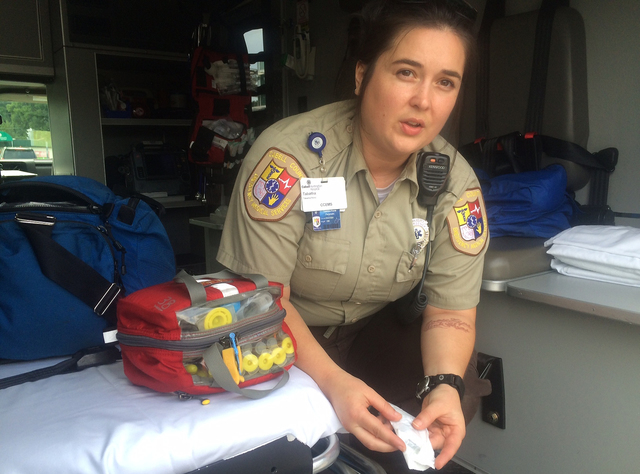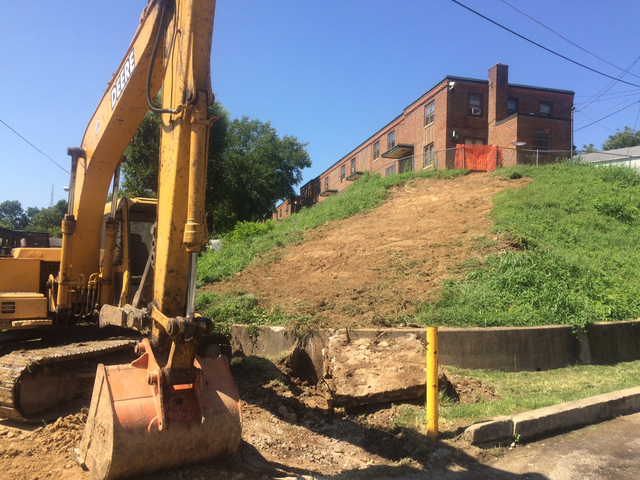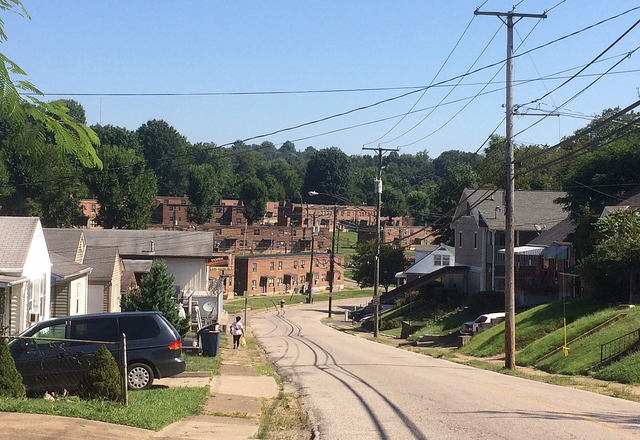How the heroin epidemic choked a West Virginia city on one August day
HUNTINGTON, W.Va. — He found the woman slumped over the steering wheel, an empty syringe on the floorboard and her skin dulling to a purplish blue.
Dave McClure, an EMS supervisor, counted four faint breaths per minute. Without the antidote he carried, she’d be dead in five minutes.
It was 3:25 p.m. on what was, so far, an ordinary Monday. For an EMT in this struggling city, bringing an addict back from the brink of opiate-fueled death counts as routine.
But as McClure searched for an unscarred vein in the young woman’s arm, dozens of others were shooting or snorting the same toxic powder she’d just taken. They started dropping, their muscles seizing, pupils shrinking to the size of pinheads. The heroin epidemic that had been quietly killing by the thousands began boiling to a climax that would traumatize the city and exhaust its emergency responders.
McClure’s radio squawked as he pushed in the IV full of a liquid called naloxone, which blocks the effects of opioids and jolts those overdosing back to life. “We’ve got another overdose,” the dispatcher reported. “We’ve got two more.”
The woman’s eyes blinked open.
Red lights on the phone at the 911 dispatch center flashed faster and faster until all 16 lines were screaming. They called from the dining room of a rickety house, the parking lot of a fast food restaurant, the bathroom of a gas station.
“People are dying everywhere,” one caller said.
___
In the next four hours of Aug. 15, 28 people overdosed in Huntington; 26 of them were saved. One man died at the hospital that night, and another was found dead and alone days later.
Ambulances darted around town as cars pulled up at the hospital, dropped overdosing people at the emergency room doors and sped away. The drugs were so potent that the ordinary dose of naloxone wasn’t enough; responders had to use two, sometimes three doses to bring them back to life.
“It was chaos here,” says Yohlanda Dixon, a 55-year-old who lives in the neighborhood where dozens overdosed. “They were all dropping the same time, like boom boom boom boom boom. That’s what was so scary. You knew they were fixing to die. And that’s the last thing you want to see, someone die right in front of you.”
But it didn’t stop there.
The string of mass poisonings stretched across Appalachia and the Midwest. The chaotic scene in Huntington has repeated day after day, in big cities and small towns, in Kentucky, Ohio and Indiana. Health and law enforcement officials in Tennessee alerted residents to the danger and asked them to seek help to end their dependency.
Law enforcement had warned for months that batches of heroin were hitting the streets laced with potent drugs like synthetic fentanyl or carfentanil, an elephant tranquilizer 100 times more powerful than heroin.
“We knew this day would happen. We didn’t know what it would be like, but we knew it was just a matter of time,” says Jan Rader, Huntington’s deputy fire chief and a registered nurse.
___
At 3:35 p.m., a man overdosed in a car in a Burger King parking lot.
At 3:39 p.m., three people had collapsed inside an apartment.
At 3:45 p.m., McClure arrived alone at a house and found a man in his 50s in the bathtub, not breathing. His friends had turned on the water to try to revive him; they were shouting, crying, smacking him in the face. A younger man lay dying in the same bathroom.
McClure was alone with them for a few minutes, but in the bedlam it seemed like an hour. Other medics arrived and they used naloxone to bring them both back.
He got in his truck and left for the next call.
Huntington sits on the Ohio River at the corner of West Virginia, Kentucky and Ohio. It was once a bustling railroad depot. But the coal industry collapsed. People lost jobs, lost hope, and now nearly one-third of residents live in poverty.
West Virginia’s rate of drug overdose deaths is the highest in the nation, according to the Centers for Disease Control and Prevention, and Huntington’s is higher still. At least 944 people overdosed last year in the county, says Scott Lemley, an intelligence analyst with the Huntington Police Department.
In the chaos, detectives started searching apartments, trying collect evidence about who was handing out the tainted drug. Within days, police would arrest an Ohio man named Bruce Lamar Griggs in connection to some of the Huntington overdoses.
But they learned long ago that arresting dealers wouldn’t solve the problem.
___
The endless cycle of death and misery is taking its toll on first responders, says Steve Murray, the EMS assistant director. Three EMTs left the department last month alone.
On Aug. 15, responders saved 26 lives, but only because they had had so much practice.
They brought people back to life in apartments, on street corners, in the bathroom of a gas station.
Dixon stepped out of her back door around 5 p.m. She saw a man, scrawny and staggering near the wood line in her back lawn. She watched him topple over, face down into the grass, and ran to him. His lips were already turning gray.
She screamed for help and the paramedics ran over, shot him twice with naloxone and he finally came to.
McClure recalls the rest of the day in flashes: a man lying on a trail in the woods at 5:15 p.m., surrounded by syringes; a man and woman in a house nearby at 6:20 p.m.; a middle-aged man who’d been dragged to the sidewalk and left for dead at 6:30.
Some cried when they awakened and realized they’d come within minutes of dying, McClure says. Some fought, some shrugged, some said thank you and apologized.
“At the end of the day, we gave 26 people another chance at finding recovery. That’s how I try to look at it. Hopefully, maybe they’ll all live,” McClure says.
McClure’s next shift, a few days later, returned to routine: 12 overdoses. It was a good day, by comparison.



















